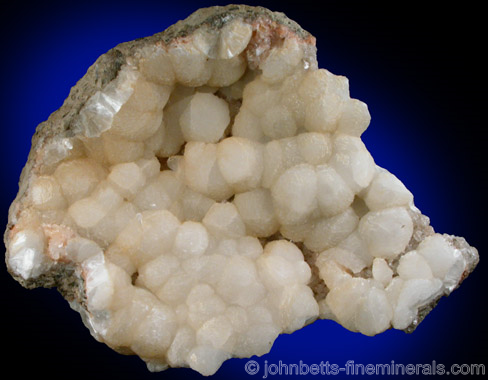The Mineral thomsonite

Thomsonite is an uncommon and desirable member of the zeolite group, forming in unique and interesting crystal aggregates. In 1997,
the Zeolite Subcommittee of the IMA divided this mineral into
two individual sub-species, thereby regarding Thomsonite as a series of two members. The series is defined by calcium and strontium end members. Common Thomsonite, which is calcium-dominating, is called Thomsonite-Ca, and is usually pure without any strontium. Strontium-dominating Thomsonite is known as Thomsonite-Sr, and is extremely rare. Almost all Thomsonite specimens in
collections are Thomsonite-Ca. A distinction among the two Thomsonite types is rarely made, and the term Thomsonite is generally used without any further breakdown.
An interesting habit of Thomsonite is as rounded, concentric bands, which are polished into aesthetic rounded stones. This form is most well-known at Thomsonite Beach at Grand Marais, Minnesota, on the shoreline of Lake Superior. It usually forms in association with other zeolites and green Chlorite. Thomsonite is named in honor of Scottish mineralogist and chemist Thomas Thomson.
Chemical Formula
Thomsonite-Ca: NaCa2Al5Si5O20 · 6(H2O)
Thomsonite-Sr: Na(Sr,Ca)2Al5Si5O20 · 7(H2O)
Color
White, beige, cream, light yellow, light gray, light brown, light orange, light pink. Sometimes banded in multicolored radiating rings.
Crystal System
Orthorhombic
Properties
Streak
White |
Hardness
5 - 5.5 |
Transparency
Transparent to translucent |
Specific Gravity
2.3 - 2.5 |
Luster
Vitreous, silky |
Cleavage
1,1;1,2 |
Fracture
Conchoidal, uneven |
Tenacity
Brittle |
Crystal Habits
In platy aggregates, in
distinct curved aggregates of fan-shaped or mushroom-shaped formations, in rounded balls of radiating crystals, and in rounded ball agglomerations or in interconnected rounded crystals. Also in wheat sheaf bundles, radiating, fan-shaped formations, acicular, bladed, and globular.
Varieties
-
Variety of banded and often concentric Thomsonite in nodular form from the Grand Marais area of Minnesota on the shores of Lake Superior. This variety name is usually applied to tumbled or polished forms.
Uses
Thomsonite is a rare collectible mineral and is especially important to zeolite collectors. Radiating, banded Thomsonites from Michigan are often tumbled and polished, and may be used as minor jewelery objects such as beads.
Noteworthy Localities
Some of the finest Thomsonite comes from several localities in the Faroe Islands (Denmark), usually as rounded, spiky balls. Jelly-like, rounded balls are well-known from Děčín, Ústí Region, Bohemia, Czech Republic; and , light pink aggregates come from Hammerunterwiesenthal, Erzgebirge, Saxony, Germany. Radiating banded Thomsonite comes from Lomba dos Pianos Quarry, Magoito, Lisbon District, Portugal; and large crystal clusters were found in the Amudikha River area, Evenkia, Russia. Some of the finest Thomsonite comes from the basalts of India, in splendid globular aggregates in light orange and pink balls at the Aurangabad and Jalgaon Districts in Maharashtra state.
In the U.S., some of the best Thomsonite aggregates, often as mushroom-like radiating masses, were found in the Upper and Lower New Street Quarries, Paterson, Passaic Co., New Jersey. Individual white crystals on Prehnite have also come from there, as well as nearby Prospect Park, also in Passaic Co. Beautiful, multicolored and banded Thomsonite is well-known at Thomsonite beach, Grand Marais, Cook Co., Minnesota. These forms are usually polished and tumbled, and may even be polished while remaining on their basalt matrix. Good Thomsonite can be found at North Table Mountain, Golden, Jefferson Co., Colorado. In Oregon, round balls aggregates are found in Goble, Columbia Co.; and light orange masses at Drain, Douglas Co.
Distingushing Similar Minerals
Stilbite - Different aggregate formation.
Natrolite - Usually less rounded.